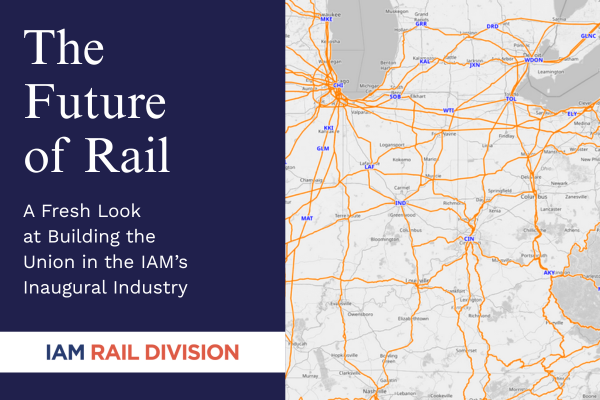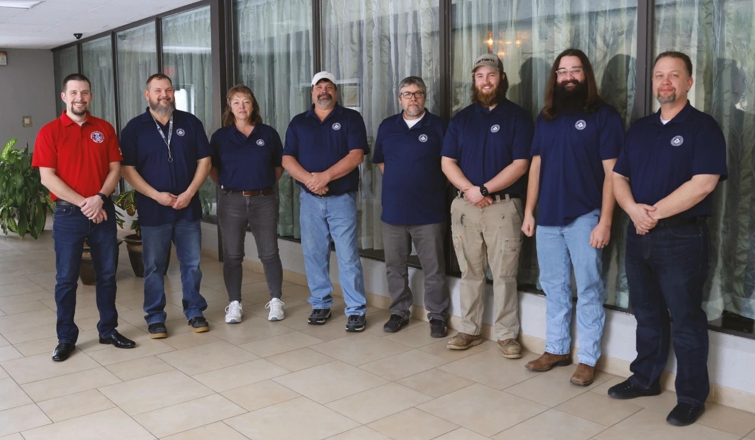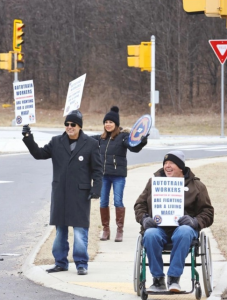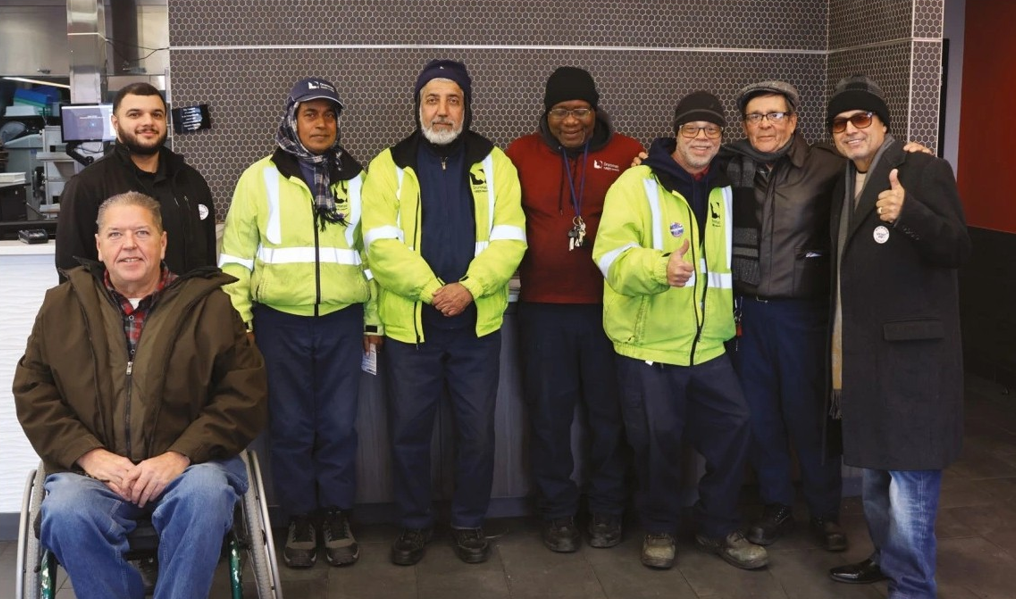

This article was featured in the Summer 2025 IAM Journal and was written by IAM Communications Representative Angela Colaizzi.
IAM Union originated on the railroads, founded in 1888 by 19 railroad machinists in Atlanta, who at the time earned a mere 20 to 25 cents per hour for a 10-hour workday maintaining locomotives and equipment.
By the early 20th century, the union had established itself as a major force in the railroad industry, advocating for standardized wages, safer working conditions, and fair grievance procedures.
Over 137 years, IAM has expanded its reach across various sectors, including aerospace and transportation, organizing workers for union representation with the same original mission: improving the lives of working people.
In 1899, thirty-three railroad clerks formed the Order of Rail- road Clerks of America in Sedalia, Mo. This group evolved to become the Transportation Communications Union, eventually merging with IAM to become the IAM Rail Division.
Now, IAM Rail Division members hold an assortment of positions at major rail carriers and transit agencies to keep the country moving: machinist, mechanic, clerk, carmen, yardmaster, on-board service worker, transit worker and more.
Although these two unions have upheld their significant presence in the ail industry since inception, the IAM Rail Division has not settled for maintaining the status quo. It brings fresh energy towards building membership wherever there is opportunity.
“We have to organize or die. We need to focus and give our reps and organizers everything they need to be successful in growing our union, said Special Assistant to the International President and head of the Rail Division Josh Hartford. * We’re not just saying that, we`re doing it. These impressive wins by IAM and TCU organizers are proof of that.”

“This was not the first attempt at this property,” said IAM District 19 General Chair Shaun O’Connor, who is now working towards first contract with the more than 135 full-time and part-time pro- duction employees who build and repair rail cars and locomotives at Alstom Transportation’s facility in Plattsburgh. N.Y.
“As a General Chairman m District 19, we don’t have the opportunity to bargain brand new contracts frequently,” said O’Connor_ “The companies that we primarily negotiate with are freight railroads, commuter rail, and Amtrak, all of which have long-standing contracts with the 1AM. Some of these contracts are well over 100 years old.”
This is one reason that the organizing win at Alstom’s Plattsburgh facility is special – the members are rail workers, but unlike 98% of 1AM District 19 members working for freight railroads, they work in rail manufacturing and fall under the National Labor Relations Act (NLRA), as opposed to the Railway Labor Act (RLA).
The NLRA applies to most private sector employers, while the RLA specifically addresses labor relations for employers m the railroad and airline industries to protect from disruptions to interstate commerce which could affect the nation’s entire economy.
“Under the Railway Labor Act, our contracts are amendable; they never expire. So, we modify them,” said O’Connor_ “We don’t frequently get the chance to start fresh from the ground up, and that makes this win exciting for us.”
Joe Cicala, 1AM Organizing International Representative, was the organizer who helped Alstom workers file for union representation, and like O’Connor said, it wasn’t the first time.
Cicala had worked on a campaign in 2023 that went to election. Employees faced union-busting tactics and Alstom management promised things would get better, so the effort lost by three votes.
“It really comes down to the fact that we had such an incredible, strong inside team,” said Cicala. “If you don’t have that, you’re not going to have a successful campaign.”
“We flipped a lot of people when through their own research they saw that everything we were telling them was true. It was a uni ted front this time,” said Cicala. “Doing this for almost IO years now, to win a campaign with a unit of this size in six weeks, from day one to election, is unheard of and shows how incredibly strong the team was. It was just true solidarity among the workers.”
Plattsburgh Alstom workers also got encouragement from the 250 JAM Local 2741 members who work at Alstom’s Hornell, N.Y plant, who made significant gains in their most recent five-year contract with the company, including wage increases, over time and double time rate protection, a freeze on healthcare costs, and enhanced paid time off.
Newly appointed !AM Assis tant General Chairman/Organizer for District 19 Nate Tinsely is taking the fight to Wabtec in Kansas City, working to organize machinists who build and repair locomotive components.
At the start of this campaign, Tinsely was on the floor working as a diesel mechanic at the Argentine Locomotive Maintenance and Inspection Terminal, a 24/7 loco motive repair shop located within the BNSF Railway’s Argentine Yard. When he wasn’t working, he was handling Local Chairman duties or organizing.
“I knew that there was a Wabtec facility organized with !BEW that specifically works on traction motors, but there was another shop I was unaware of that rebuilds and repairs pretty much every part we put on a locomotive,” said Tinsely.
“We have some Wabtec workers in our facility who handle material and offer some technical support – that’s actually who I heard about it from,” said Tinsely. “I heard them talking about looking to see if there were parts over at the facility in Kansas City, and then my mind was already going.”
Tinsley had been through some organizing training at IAM’s Winpisinger Education and Technology Center and immediately noticed the opportunity.
“I kind of put my feelers out. I tried to find out if I knew anybody who knew somebody who worked there, through family friends,” said Tinsely. “But I just didn’t find anybody. So I made up some flyers, went out there and put them on cars.”
Presently, Tinsely is still in the education part of the campaign, trying to spread the word and teach Wabtec workers, many of whom speak primarily Spanish, about their rights and what the company can and can’t do.
“In my shop, we have a legacy contract, where it’s just been around for a hundred years. I try to explain to the workers we’re organizing that once you have a union and you start negotiating contract after contract, you just gain. It only gets better,” said Tinsely.

Sal Rodriguez (front) and Sean McGrath at the Lorton, Va., Auto Train location for an informational picket on Drummac.
TCU/IAM Organizing Direct tor Sal Rodriguez and Organizing Coordinator Drew Maratea are using similar strategies in their recent organizing wins: building strong core groups and detecting leads internally.
Fifty-five chalkers, inspectors, and drivers who work on Amtrak’s Auto Train for the sub-contracting employer Drummac saw first-hand what union representation does for Amtrak workers by working alongside them.
TCU/IAM is the lar gest union on Amtrak, and Drummac workers in Lorton approached TCU National Representative Mitch Canter, a former Amtrak worker and TCU Local Chairman at the site, seeking better wages, safety improvements, and support.
“Comradery and support were the major reasons I wanted to join the union,” said Anthony Byrd, a Drummac employee and new TCU member. “I also wanted a change in the status quo with what’s going on at the site I’m working at.”
“Everybody wanted to join. Everybody wanted to be a part of this movement,” said Byrd. The overwhelming 80% yes-vote in their union election proved the group’s certitude.
Now TCU National Vice President Matt Hollis is leading negotiations with Drummac for their first contract. Like O’connor, most ofHollis’s experience is bar gaining existing contracts under the RLA.
“I think this is good for our union, because under the Railway Labor Act opportunities like this aren’t always as plentiful,” said Hollis. “This is a new experience for us, and it’s not something that our union has a ton of practice in, so it’s interesting. It’s encouraging for us to see such good support and energy from the membership.”
TCU is using their deep connections in the industry to branch out and bring representation to transportation workers close to its already-represented members.
“Amtrak is such a big part of our union, and with these people being so closely connected to Amtrak, they know they have the full support of TCU,” said Hollis.
“I think this organizing win demonstrates our union’s commitment to be flexible and to adapt and to take on the challenges necessary to grow our union.”

Something similar happened with Transdev bus drivers who run routes between Mersed and Yosemite National Park, as well as other parks in between.
“That was a lead we got from a former Local Chairman, again,” said Rodriguez. “That drive was pretty interesting because they wanted to see how serious we were about organizing them, so they said ‘if you guys want to meet us, meet us at the park.’ So, we went all the way up to Yose mite National Park to meet them in their lunch room.”
Rick Cota, now a TCU Assis tant National Representative, is the former Local Chairman and Amtrak employee who worked closely with Transdev employees. “That’s the advantage that we have,” said Rodriguez. “When you have boots on the ground at these locations, they build that trust for us.”
Cota called Rodriguez saying that the bus drivers came to him, knowing that he was a union representative, saying they wan ted a union.
“There’s 28 people we organized with the crafts including bus drivers, dispatch, and utility,” said Maratea. “With Transdev, they’re growing. That number could possibly even double by the end of 2025.”
Steven Phillips is an Amtrak employee and TCU Local President who informed Rodriguez and Maratea about Alvand bus drivers who approached him because they were curious about TCU.
After winning their union election with 53 new members, Alvand hired more people, and the group grew to 85. If the company wins a contract bid with Amtrak, the owner of Alvand is anticipating hiring even more, up to a total of 120 employees by the end of 2025.
“It just goes to show that the spots we’re organizing in are growing, too,” said Maratea.
“While we’re not huge, our group is maybe ten to fifteen strong, we have people all over who are looking for opportunities. They’re hungry and motivated; they do whatever it takes when it comes to an organizing drive,” said Rodriguez.
‘These were three wins we were able to get because we have boots on the ground in all these different locations,” said Rodriguez. “The local chairmen are out there seeing other workers on the ground, working with them, and they are able to come to us with leads,” said Rodriguez.